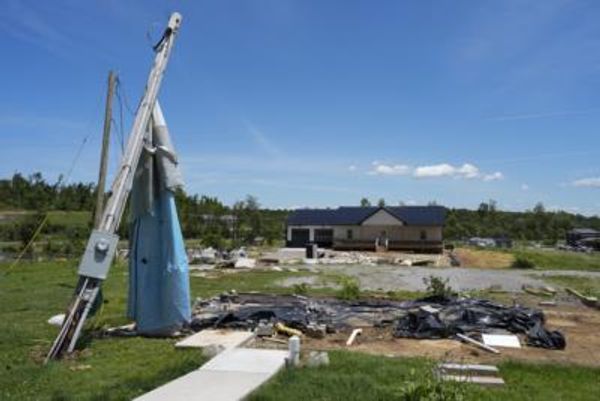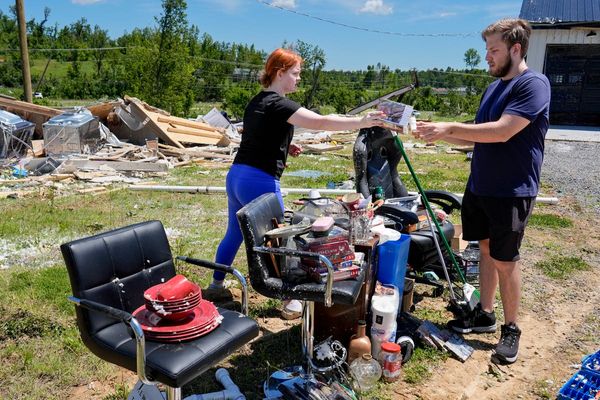
The sun beamed through a cloudless sky across parts of California on Thursday, offering a much-needed break from relentless rains that have drenched the state for weeks. The window of good weather wouldn’t last long. The 12th atmospheric river in mere months is expected to unleash a new set of hazards across the sodden state early next week.
“[The storm] is going to exacerbate things further with the flooding and the other impacts going on unfortunately,” said Jon Gottschalck, who heads the operational prediction branch of the National Oceanic and Atmospheric Administration’s (Noaa) climate prediction center, noting that more heavy rainfall and higher elevation snowfall is in the forecast. “It is also going to hamper ongoing relief efforts.”
Forty of California’s 58 counties remain under emergency declarations and with little time to spare before the next dousing, officials and residents across the state rushed to secure saturated hillsides and inundated infrastructure, and clear strewn debris and downed trees left behind by the last storm.
Repairs in the breached levee that left the town of Pajaro submerged are ongoing as crews work to fill holes with stones and sand. Hundreds of displaced residents who had to escape the rushing waters before dawn last Saturday remain in shelters scattered throughout the region. Some may have nothing to return to.
Down the coast, the rains chewed into mushy hillsides that line the coast in Orange county, prompting evacuations as homes dangled precariously over the bluffs that gave way behind them. Sinkholes opened in streets across the state since the storms began, swallowing cars and adding to travel headaches exacerbated by winter weather closures, flooded roadways and thoroughfares clogged with mud.


Meanwhile, mountain towns tucked along the Sierra Nevada range spent weeks socked-in by the snow that buried homes and businesses and left mounds as high as buildings. Officials have not yet determined the extent of the winter storms’ damage overall, but dozens are believed to have lost their lives as a result of the severe weather since the start of the year.
The dramatic swing from devastating dryness to drenched has compounded the effects of the storms, as drought-weakened trees were easily pummeled by thrashing winds kicked up during the storms, and punched trees through windows, across roads, and into power lines, leaving thousands in the dark. Wildfire burn scars left sparsely vegetated slopes vulnerable to slides.
“It has really been a weather whiplash all throughout the season,” said Brian Ferguson, a deputy director for California governor’s office of emergency services, adding that years of drought followed by so much precipitation put extra pressure on state systems.
While the next round of rain may not be as strong as what the state has already received, he added, “because of the cumulative impact, we are still in a situation where things can get dangerous quickly”.
And, with impacts still being felt across the state, emergency responders and resources are running thin.
“There are only a certain number of firefighters, national guard, and local first responders, so we are trying to load balance across the state,” Ferguson said, noting that for many areas people will have to rely on their own preparation and rally together as communities. “It’s so widespread that first responders won’t be able to help every single person if the whole state is hit at the same time.”
That’s why, he added, state officials are focused on messaging. Along with added hazards when the climate shifts from dry to wet, residents and visitors may not have the experience and tools needed to get them through.
“Water in some ways feels less dangerous than a wildfire bearing down on you but water actually kills far more people in our country every year than fire,” he said, adding that the state is hoping to help the public “understand their risks as we haven’t seen these storms in several years”.

The end is in sight – at least in the short term – as the shift into spring should ease the onslaught of California’s precipitation. Typically, California’s rainy season stretches only into the first three months of the year before falling off dramatically.
“It does look like the faucet is going to turn off a little bit – or at least it will be more of a drip, rather than a constant fire hose,” Gottschalck said. But that doesn’t necessarily mean flood concerns will abate.
Stacked high atop the mountains, the Golden State’s epic snowpack will start to melt as the weather warms. How quickly – and how dangerously – comes down to heat. A gradual melt produces a beneficial flow that provides relied-upon moisture through the drier months. A rapid runoff could spell another disaster, even after the rains cease.
“The problem comes when you get anomalously warm temperatures for a week or two,” Gottschalck said. “With that much snow, if that case were to materialize, there would undoubtedly be severe flooding in many areas.”

But the cold drenching California has gotten through the winter could help stave off hotter days, he added. Below-average temperatures are in the forecast for the start of spring as evaporating moisture will leave landscapes cooler. That could also help delay the onset of fire season across the west – but it won’t protect against infernos through the summer.
The verdant grasses spurred into growth by the incessant downpours could soon turn to fuel for flames as the weather warms. It’s still unclear what’s in store for the summer and autumn months when fire risks peak in California.
And, longer term, the flip from dry to wet is just as likely to flip back with equal intensity.
“It’s entirely consistent with what we expect to see in a climate change scenario,” Gottschalck said. “Going from an unbelievable drought that took years in the making to a lot of it being eradicated in a month or two months is pretty extreme,” he added. “And in the warming environment that we are in, extremes are more likely – whether they be dry, wet, warm, or cold.”







